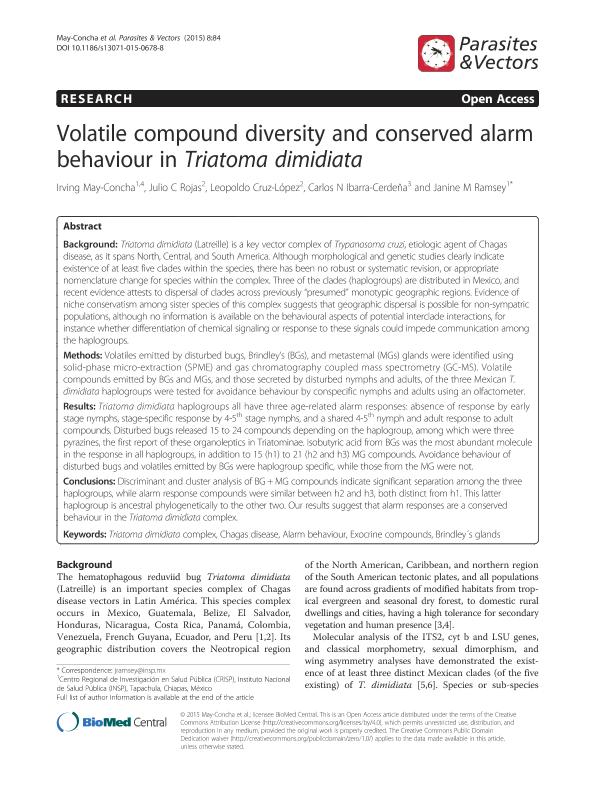Mostrar el registro sencillo del ítem
dc.contributor.author
May Concha, Irving Jesus

dc.contributor.author
Rojas, Julio C.
dc.contributor.author
Cruz López, Leopoldo
dc.contributor.author
Ibarra-Cerdeña, Carlos N.
dc.contributor.author
Ramsey, Janine

dc.date.available
2019-07-23T22:22:40Z
dc.date.issued
2015-02
dc.identifier.citation
May Concha, Irving Jesus; Rojas, Julio C.; Cruz López, Leopoldo; Ibarra-Cerdeña, Carlos N.; Ramsey, Janine; Volatile compound diversity and conserved alarm behaviour in Triatoma dimidiata; BioMed Central; Parasites and Vectors; 8; 1; 2-2015; 1-14
dc.identifier.issn
1756-3305
dc.identifier.uri
http://hdl.handle.net/11336/80110
dc.description.abstract
Background: Triatoma dimidiata (Latreille) is a key vector complex of Trypanosoma cruzi, etiologic agent of Chagas disease, as it spans North, Central, and South America. Although morphological and genetic studies clearly indicate existence of at least five clades within the species, there has been no robust or systematic revision, or appropriate nomenclature change for species within the complex. Three of the clades (haplogroups) are distributed in Mexico, and recent evidence attests to dispersal of clades across previously "presumed"monotypic geographic regions. Evidence of niche conservatism among sister species of this complex suggests that geographic dispersal is possible for non-sympatric populations, although no information is available on the behavioural aspects of potential interclade interactions, for instance whether differentiation of chemical signaling or response to these signals could impede communication among the haplogroups. Methods: Volatiles emitted by disturbed bugs, Brindley's (BGs), and metasternal (MGs) glands were identified using solid-phase micro-extraction (SPME) and gas chromatography coupled mass spectrometry (GC-MS). Volatile compounds emitted by BGs and MGs, and those secreted by disturbed nymphs and adults, of the three Mexican T. dimidiata haplogroups were tested for avoidance behaviour by conspecific nymphs and adults using an olfactometer. Results: Triatoma dimidiata haplogroups all have three age-related alarm responses: absence of response by early stage nymphs, stage-specific response by 4-5th stage nymphs, and a shared 4-5th nymph and adult response to adult compounds. Disturbed bugs released 15 to 24 compounds depending on the haplogroup, among which were three pyrazines, the first report of these organoleptics in Triatominae. Isobutyric acid from BGs was the most abundant molecule in the response in all haplogroups, in addition to 15 (h1) to 21 (h2 and h3) MG compounds. Avoidance behaviour of disturbed bugs and volatiles emitted by BGs were haplogroup specific, while those from the MG were not. Conclusions: Discriminant and cluster analysis of BG +MG compounds indicate significant separation among the three haplogroups, while alarm response compounds were similar between h2 and h3, both distinct from h1. This latter haplogroup is ancestral phylogenetically to the other two. Our results suggest that alarm responses are a conserved behaviour in the Triatoma dimidiata complex.
dc.format
application/pdf
dc.language.iso
eng
dc.publisher
BioMed Central

dc.rights
info:eu-repo/semantics/openAccess
dc.rights.uri
https://creativecommons.org/licenses/by-nc-sa/2.5/ar/
dc.subject
Alarm Behaviour
dc.subject
Brindley'S Glands
dc.subject
Chagas Disease
dc.subject
Exocrine Compounds
dc.subject
Triatoma Dimidiata Complex
dc.subject.classification
Ecología

dc.subject.classification
Ciencias Biológicas

dc.subject.classification
CIENCIAS NATURALES Y EXACTAS

dc.title
Volatile compound diversity and conserved alarm behaviour in Triatoma dimidiata
dc.type
info:eu-repo/semantics/article
dc.type
info:ar-repo/semantics/artículo
dc.type
info:eu-repo/semantics/publishedVersion
dc.date.updated
2019-07-23T12:59:57Z
dc.journal.volume
8
dc.journal.number
1
dc.journal.pagination
1-14
dc.journal.pais
Reino Unido

dc.journal.ciudad
Londres
dc.description.fil
Fil: May Concha, Irving Jesus. Provincia de Entre Ríos. Centro de Investigaciones Científicas y Transferencia de Tecnología a la Producción. Universidad Autónoma de Entre Ríos. Centro de Investigaciones Científicas y Transferencia de Tecnología a la Producción. Consejo Nacional de Investigaciones Científicas y Técnicas. Centro Científico Tecnológico Conicet - Santa Fe. Centro de Investigaciones Científicas y Transferencia de Tecnología a la Producción; Argentina. Instituto Nacional de Salud Pública; México
dc.description.fil
Fil: Rojas, Julio C.. El Colegio de la Frontera Sur; México
dc.description.fil
Fil: Cruz López, Leopoldo. El Colegio de la Frontera Sur; México
dc.description.fil
Fil: Ibarra-Cerdeña, Carlos N.. Instituto Politécnico Nacional. Centro de Investigación y de Estudios Avanzados; México
dc.description.fil
Fil: Ramsey, Janine. Instituto Nacional de Salud Pública; México
dc.journal.title
Parasites and Vectors

dc.relation.alternativeid
info:eu-repo/semantics/altIdentifier/doi/https://doi.org/10.1186/s13071-015-0678-8
dc.relation.alternativeid
info:eu-repo/semantics/altIdentifier/url/https://parasitesandvectors.biomedcentral.com/articles/10.1186/s13071-015-0678-8
Archivos asociados
